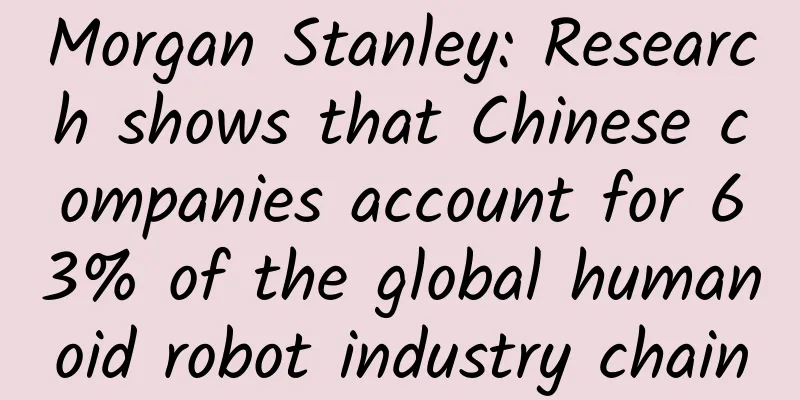Morgan Stanley: Research shows that Chinese companies account for 63% of the global humanoid robot industry chain

|
Morgan Stanley recently released "Humanoid Robot 100: Mapping the Humanoid Robot Value Chain". These companies cover core hardware such as drivers, sensors, and batteries. It is worth noting that among these companies that have confirmed their involvement in the field of humanoid robots, as many as 73% are located in Asia, and China is the leader among them, accounting for 56%. In the global humanoid robot industry chain, China's share is as high as 63%, especially in the "body" link, where Chinese integrated companies account for 45%. Morgan Stanley further pointed out that the current status of the humanoid robot ecosystem is that Western investors have relatively limited choices in their humanoid robot portfolios, mainly concentrated on a few companies such as Tesla and Nvidia. In contrast, China’s progress in the field of humanoid robots stands out, thanks to the fact that Chinese start-ups benefit from a mature supply chain, abundant local application opportunities, and strong support at the national level. Among the major humanoid robot products in the world, Chinese companies occupy an important position. Six companies, including Zhiyuan Robotics, Fourier, Star Robotics, UBTECH Robotics, Yushu and Xiaopeng Motors, together with American companies such as Agility Robotics, Apptronik, Boston Dynamics, Figure and Tesla, constitute the main players in the humanoid robot market. In order to more clearly present the full picture of the humanoid robot industry chain, Morgan Stanley divides the top 100 list into three modules: brain companies, body companies and integrators. Brain companies are mainly responsible for providing semiconductors and software, which are the key to realizing the autonomous functions of humanoid robots. They include internationally renowned companies such as Oracle, Siemens, Meta, Samsung Electronics, as well as China's Baidu and Horizon Robotics. Body companies focus on providing physical components such as actuators, sensors, wires and batteries, which constitute the "flesh" part of humanoid robots. This field has the largest number of companies, with a total of 64, including internationally renowned companies such as ABB, Infineon, Rockwell, as well as China's Xusheng Group, Yiwei Lithium Energy, and CATL. Integrators are companies responsible for manufacturing complete humanoid robots. These companies are usually large in scale, and some of them already have robotics businesses. There are 22 companies in this field, including international giants such as Hyundai, Toyota, and LG Electronics, as well as nine Chinese companies such as GAC Group, Xiaopeng Motors, and BYD. The Morgan Stanley report also highlights the huge potential of the humanoid robot market. In the United States, about 75% of occupations and 40% of employees may be replaced by humanoid robots to some extent, with a potential market size of about $3 trillion. In China, it is expected that by 2050, the humanoid robot market size will reach 6 trillion yuan, and the total number will reach 59 million units. This data undoubtedly provides huge room for imagination for the future development of the humanoid robot industry. Zikuai Technology |
<<: AI is here, and the most panicked ones are Taobao models
>>: Will Android devices and iPhones support Windows 10's "killer app"?
Recommend
Xiaobai Moving Brick Project 1.0, pure mobile phone operation, earn some pocket money every day
Xiaobai Moving Brick Project 1.0, pure mobile pho...
World police also love domestic cars? Wuling Guangguang appeared on the US military asset auction website
As the "domestic magic car" in the eyes...
China Automobile Dealers Association: Analysis of China’s automobile exports in 2020
China's domestic auto market has been on a do...
Is it true that the "first aurora appeared in Chongqing" is true? A starry sky photographer is here to answer the question!
On August 14, a photographer posted a photo of an...
Why is it more difficult for some people to get over a broken heart?
© Eric Thayer/Reuters Leviathan Press: Humans are...
Which workers will be replaced by robots? The latest algorithm gives you the answer
When people think about a future with intelligent...
Another breakthrough in AI! Identifying children's "invisible killer" before the age of 1, with an accuracy rate of over 80%
Autism is becoming the "invisible killer&quo...
How does a brand do marketing? If Apple sells apples, would you buy them? ?
Let’s first look at two interesting marketing hyp...
Qige's "30 Lessons in WeChat Moments Marketing" video Baidu Cloud download
As one of the windows for displaying individuals ...
What are the conditions for opening a Douyin store? What are the requirements for setting up a Douyin store?
Since the launch of Douyin Stores , more and more...
Zhulu Academy_Traditional Ancient Eight Characters Practical Course Baidu Cloud Download
Zhulu Academy · Traditional Ancient Eight Charact...
6 creative information flow formulas to solve the pain points of users in the loan industry one by one!
Place information flow ads , I examine myself thr...
Wuchang SEO Training: How to choose a server for SEO black hat site cluster optimization?
Let’s first talk about what a cluster server is. ...
How powerful are the legendary space-based weapons? You'd never guess!
RODS FROM GOD, the legendary ultimate weapon, can...
Detailed cost breakdown for mini program production: how to reduce mini program development costs?
How much does it cost to develop a mini program ?...









